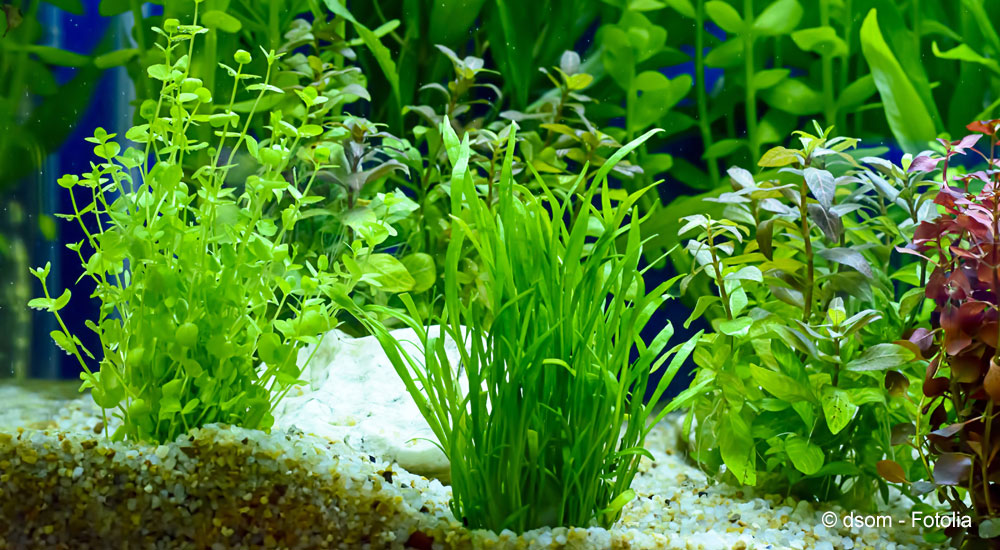Java moss (Taxiphyllum barbieri)
Java moss is a little ‘jack of all trades’ in aquariums. It can float freely in the water or be connected to stones or roots, enabling you to plant it wherever you please. Furthermore, Java moss requires very little light and can tolerate a wide range of water hardness levels and temperatures. This makes it suitable for almost any aquarium. One final note: several different moss species are sometimes referred to and sold as ‘java moss’, e.g. Singapore moss (Vesicularia dubyana).
Dwarf anubias (Anubias barteri var. nana)
Where possible, dwarf anubias should be used as an epiphyte but can sometimes also be planted in gravel. Most species of anubias cope fine with poor light conditions and have few requirements with regard to water hardness and nutrients. Dwarf anubias propagates itself by growing from rhizomes (small stems) and is also easy to attach to decorative features. Native to Cameroon, plant-eating fish tend to leave dwarf anubias alone. This explains its common use in cichlid aquariums.
Wendt’s water trumpet (Cryptocoryne wendtii)
Wendt’s water trumpet comes from Sri Lanka and grows to a height of up to 30 cm. It is a robust rosette plant that can flourish with little light and in a wide range of water hardnesses. This fast-growing plant is suitable for almost any aquarium, but especially newly created ones, where it can help to quickly eliminate the sparse appearance. It is furthermore available in several different growth forms and colours.
Eelgrass (Vallisneria spec.)
Its tall, slender form makes eelgrass an ideal plant for the back of large aquariums. However, you should always take care when choosing specific species or cultivated varieties as the leaves of some plants can grow to 150 cm long! Eelgrass actively propagates through offshoots and sometimes needs to be given boundaries; otherwise it can completely take over your aquarium. It copes well with poor light conditions and also grows well in sandy soil. Last but not least, it is one of the plants stocked as standard by specialist retailers that can flourish even in hard water.
Various stem plants
There are numerous highly attractive stem plants that make great visual features in aquariums thanks to the shape of their leaves and their colours. Examples of the best known stem plants include species from the genera bacoba (Bacoba), hygro (Hygrophila), ambilia (Limnophila), ludwigia (Ludwigia) and rotala (Rotala). Prior to buying stem plants, you should always check their requirements with regard to water quality and light. Most are very fast growing and require occasional trimming to stop them getting too tall. Often, you can replant the sections that you have trimmed off as cuttings. Usually sold and planted in bunches, stem plants are ideal when first setting up an aquarium due to their rapid growth.
Water sprite (Ceratopteris thalictroides)
Found in tropical waters worldwide, water sprite is also a popular choice among aquarium owners. The rosette-forming fern grows quickly and requires an average to high amount of light. It can also flourish as a free-floating plant on the surface of the water. To do so, however, it needs a minimum temperature of 22 degrees.
Marimo moss balls (Aegagropila linnaei)
You don’t generally want algae in your aquarium – with the exception of these decorative and very slow-growing algae balls that is. These undemanding, shade-loving moss balls act as a source of food for shrimps and are also ideal for nano aquariums. As an added bonus, they can be easily cleaned by rinsing them under running water. Just make sure you don’t use warm water as the robust algae aren’t at all keen on it.
Amazon sword plant (Echinodorus bleheri)
Amazon sword plant is a beautiful solitary plant that is sold under several scientific names. Growing to up to 60 cm tall, it has been one of the most popular aquarium plants for many years. This is also because it is so adaptable and flourishes in all sorts of different light conditions and water qualities. To make your plants particularly hardy, carefully fertilise their roots with fertiliser tablets.
Other sword plants (Echinodorus spec)
There are several natural species of sword plants but also many cultivated varieties, which make your aquarium look truly magnificent thanks to not only the shape but also the reddish colour of their leaves, for example. Ask your pet retailer for advice as several Echinodorus have specific requirements with regard to the aquarium size, water quality, light etc.
Crinkled Aponogeton (Aponogeton crispus)
Growing to heights of up to 50 cm, the crinkled Aponogeton and other Aponogeton species are ideal for background decoration. As such, the long, thin leaves with crinkled edges can be seen in many aquariums. Please note, however, that these plants need good light and plenty of nutrients to flourish. Furthermore, the water bodies in their home country of India regularly dry out. The plants therefore need dormant periods, during which they retract into their tubers and can be stored at room temperature in damp sand for one or two months.
Java fern (Microsorium pteropus)
The java fern is a very common aquarium plant as it can be found in many different cultivated forms. It is a typical epiphyte, which is often sold by retailers on a stone or piece of aquarium wood. The java fern does not have any specific requirements with regard to the chemical composition and temperature of the water and is robust enough to be safely planted in most cichlid aquariums.

